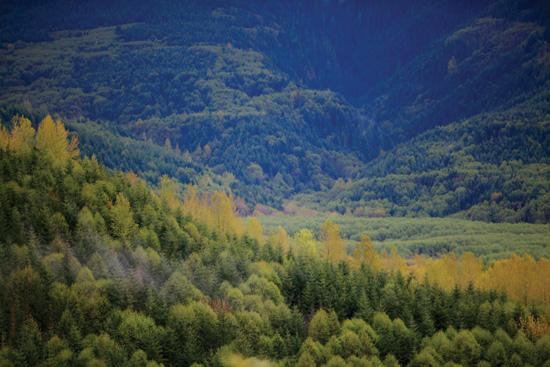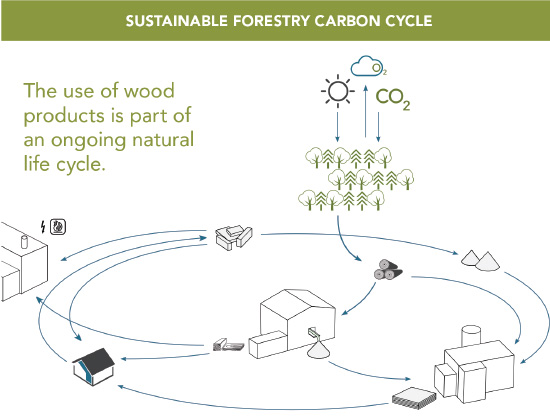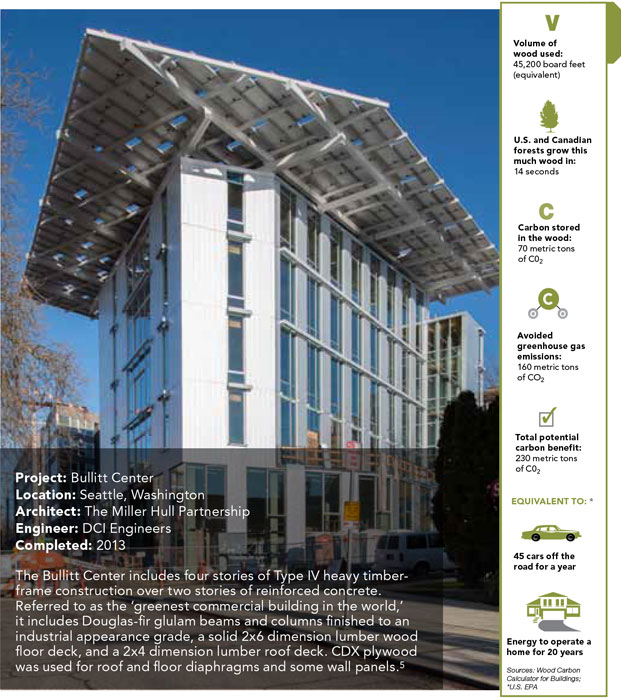Evaluating the Carbon Footprint of Wood Buildings
Calculating Carbon Footprint
Much of the information available about the effectiveness of wood products in reducing a building's carbon footprint has been driven by an increasing focus on carbon elsewhere in the world. The European Union, for example, is seeking to reduce carbon emissions by having all new buildings achieve 'nearly net-zero energy' by 2020—i.e., very high energy efficiency where the low amount of energy that is required comes from renewable sources.
In The Netherlands, the 2012 building code requires LCA data to be submitted for each new building, and a total 'environmental shadow cost' must be calculated per square meter of building area in order to get a building permit.
The UK government will require new homes to be 'zero carbon' beginning in 2016, and is considering extending this to all buildings as of 2019.
Other policies go further, explicitly recognizing the benefits of forestry and wood use:
▶ In the UK, climate change policy includes carbon sequestration via tree planting and forest management, the production of wood fuel as a renewable energy source and the promotion of wood products as a substitute for more carbon intensive materials.
▶ In France, the government requires that new public buildings have at least 0.2 cubic meters of wood for every 1 square meter of floor area.
▶ In New Zealand, wood or wood-based products must be considered as the main structural material for new government-funded buildings up to four floors.
▶ The Japanese government introduced a law requiring wood to be considered as the primary building material for any government-funded project up to three stories, and for any privately funded building used in a public manner such as elderly care facilities.
▶ In Canada, the governments of British Columbia, Ontario, and Quebec have policies that encourage the use of wood in public buildings.
In the U.S., increasing emphasis on the effects of carbon in the atmosphere has motivated the development of many calculators for various products and activities. Two in particular are commonly used by U.S. architects to understand and compare the carbon impacts of their building designs.
Developed by the U.S. Environmental Protection Agency, the Greenhouse Gas Equivalencies Calculator2 translates emissions data into recognizable equivalents such as annual greenhouse gas emissions from passenger vehicles or CO2 emissions from the energy used to operate a home for a year. The second tool, the Wood Carbon Calculator for Buildings,3 was developed to allow users to calculate the carbon benefits of their wood building projects, including the amount of carbon stored in the wood products, emissions avoided by not using fossil fuel-intensive materials, and amount of time it takes North American forests to grow that volume of wood. It does this in one of two ways:
▶ If the volume of wood products is known (including lumber, panels, engineered wood, decking, siding, and roofing), the carbon calculator will provide a detailed estimate for that specific building. The more detailed the information, the better the results.
▶ If volume information is unknown, users can select from a list of common building types and receive an estimate based on typical wood use.
For the more detailed calculation, users enter the nominal volume of wood in a building, and the calculator then performs necessary volume conversions, makes corrections for moisture content, and arrives at a total mass figure of wood contained in the building. The tool then uses that information to estimate the building's carbon benefits.
Both the Greenhouse Gas Equivalencies Calculator and the Wood Carbon Calculator for Buildings were used to generate the equivalencies in this course.
Forests Absorb, Store, and Release Carbon
Responsibly managing forests in a way that balances harvesting and replanting, and provides a sustainable source of wood products that continue to store carbon and offset the use of fossil fuels, can significantly reduce the amount of carbon in the atmosphere over the long term.

Photo by Weyerhaeuser Company
On many public lands, years of fire suppression combined with a ‘hands off’ approach to management has created overly dense forests with a heightened risk of wildfire—and the resulting massive CO2 emissions. Active forest management, which includes thinning these forests to reduce the severity of fire when it occurs, protects values such as habitat and recreation while helping to ensure that forests store more carbon than they release.
As trees grow, they clean the air we breathe by absorbing CO2 from the atmosphere. They release the oxygen (O2) and incorporate the carbon (C) into their twigs, stems, roots, leaves or needles, and surrounding soil. Young, vigorously growing trees take up carbon dioxide quickly, with the rate slowing as they reach maturity (typically 60-100 years, depending on species and environmental factors). A single tree can absorb as much as 48 pounds of CO2 per year and sequester up to 1 ton of CO2 by the time it reaches 40 years old.4
As trees mature and then die, they start to decay and slowly release the stored carbon back into the atmosphere. Carbon is also released, but more quickly, when forests succumb to natural hazards such as wildfire, insects or disease.

Source: Building with Wood – Proactive Climate Protection, Dovetail Partners Inc.

Photo by John Stamets
Growing forests absorb, store, and release carbon over extended periods of time. According to a new report by the Dovetail Partners consulting group, U.S. forests add more than twice as much wood through new growth annually than is removed or lost through natural mortality. As a result, wood volumes contained within the nation's forests have been increasing. Citing research from the U.S. Forest Service, the report states: “The amount of forestland area in the U.S. has been essentially constant since 1900. This reality and a long history of positive net growth (growth in excess of mortality and removals), coupled with improvements in forest management and supported by strong markets for forest products, have resulted in U.S. forests storing more carbon than they release into the atmosphere (i.e., they are a net carbon sink). In fact, scientists estimate that U.S. forests have been a net carbon sink since the early 1900s.” The Forest Service estimates that U.S. forests store approximately 67 metric tons of carbon per acre.6
These conclusions are echoed in the National Report on Sustainable Forests – 2010,7 which states, “Total U.S. forest area, as defined for the purposes of this report, currently amounts to 751 million acres, or about one-third of the nation's total land area. Since the beginning of the past century, the size of this inventory has been relatively stable, and the forests it represents remain largely intact…” In the U.S., forests and forest products store enough carbon each year to offset approximately 10 percent of the nation's total CO2 emissions.8









